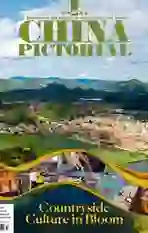Art Empowering Rural Revitalization
2022-04-29byXuBaicheng
by Xu Baicheng
Art practitioners have been encouraged to travel deep into rural areas to revitalize rural communities in China. Many have looked to Rongjiang County in Qiandongnan Miao and Dong Autonomous Prefecture, southwestern Chinas Guizhou Province, to practice art because the county is known for its multiple ethnic groups, rich folk cultures, and well-preserved local lifestyles.
Since its inception in August 2019, the public art initiative themed “The Book of Earth”has teamed up activists from the fields of humanities, academics, art, and architecture to experiment with exhibitions, public buildings, installation art, soundscaping, and video art in rural areas of Qiandongnan. Leveraging the long-standing craft of indigo dyeing in Rongjiang, it sought to map out sustainable development plans to transform traditional culture and revive rural areas through promoting public art creation and reconstructing local living spaces.
Energizing Power between Urban and Rural Areas
Wang Sha, the founder of the public art initiative, bonded herself with Rongjiang when she participated in a charity program in which she and other volunteers from metropolises like Beijing, Shanghai, and Shenzhen helped sell oranges from the county. The profits from the program were used to support local singers and children to practice the Grand Song of the Dong ethnic group, a folk chorus performance that was added to the UNESCO World Heritage List in 2009.
Local people were holding their traditional Chixin Festival to celebrate the harvest when Wang first visited Rongjiang. After admiring the Grand Song performance, she and a few tourists were warmly invited to dine with local families. Local villagers believe that harvest should be shared with others and more sharing would beget a better harvest next year. Wang was deeply touched and felt energized by the local peoples affection nurtured by ancient agricultural civilization.
From that point, she became determined to care for and revitalize the rural land, following the footsteps of Yan Yangchu,Tao Xingzhi, and Fei Xiaotong and other Chinese intellectuals who devoted themselves to rural research in the 20th century. Instead of acting impulsively, she made preparations for nearly 10 years before launching the public art initiative in Qiandongnan.“Rural revitalization should be sustainable and based on joint contributions,” she explained.
Art Created by Artists and Villagers
Wang Sha believes the essence of public art is to activate local public spaces through art design, and not only artists and designers but also local villagers should contribute to it. Public art should always serve the public. It should become an important draw for future rural cultural tourism.
Committed to exploring the local culture nurtured by Rongjiang County, more than 20 artists, architects, and designers have made many visits deep into the hinterland of Dali Dong Village, Zaidang Dong Village, and Jiayi Miao Village to map out concepts and practice of public artworks based on the topographic characteristics, spatial forms, and regional functions of different villages.
Dali Dong Village is one of the best-preserved Dong villages in Qiandongnan. Designer Yao Liang and his team made full use of the complete architectural ecology and designed the “T House,” a public teahouse, to receive tourists, with its profits going back to the village.
The Grand Song of the Dong ethnic group is the soul of Zaidang Dong Village. Wang Sha launched an art program named “The Singing Village” and invited He Guofeng, Mo Chunlin and other musicians to create and perform the Grand Song online alongside local Dong people. The latest livestream attracted more than 1.6 million viewers. Spreading mouth to mouth, the online music program has created a unique brand of art and boosted the development of cultural tourism in the village.
Jiayi Miao Village is famous for its natural environment. Nestled in the depths of a mountain, the village is beautified by terraced fields in a sea of clouds. Artist Lyu Wenting chose a local cowshed as her target for renovation. She lived with the owner of the cowshed for nearly a month and traveled back and forth between the cowshed and the owners home every day to experience the strong symbiosis and emotional bond between the Miao people and their livestock. Her efforts finally paid off when she transformed the cowshed into a tourist attraction radiating bright colors.
Value Co-creation Engaging More People
Indigo dyeing is an intangible cultural heritage item preserved and passed on by Miao and Dong ethnic groups in Rongjiang. Thanks to joint efforts of the local government and people, Rongjiang County has built the largest woad planting base in the world, the largest indigo paste production factory in Asia, and an indigo dyeing art center combining functions of exhibition, design, creation, production, tourism, research, and education.
Based on the local indigo dyeing techniques, the county has developed a unique development model featuring“industry plus cultural tourism”and “rural revitalization plus cultural and creative industry”and holds the Indigo Dyeing Art Week every year. Wang Sha sees indigo dyeing as a potential bridge to connect culture and art with industry to realize sustainable development. Because it empowers each village to be identified by a unique cultural DNA, the Indigo Dyeing Art Week will continue to thrive.
“A new chapter is opening for Rongjiang,” Wang said.“Rural revitalization requires everyones participation, based on the concept of value co-creation. I hope more people will pitch in and help the book of Rongjiang be read and understood by more.”
